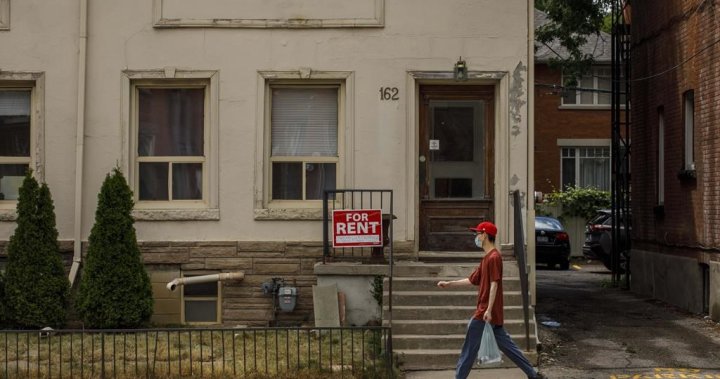This article is part of Global News’ Home School series, which provides Canadians the basics they need to know about the housing market that were not taught in school.
The Bank of Mom and Dad — an informal financial institution open to some but not all prospective homebuyers — has become a major factor in whether or not some Canadians can break into the housing market.
Having a parent or grandparent with enough spare cash to lend towards a downpayment or help with a mortgage is a privilege afforded to a lucky few, and it’s often along these lines that young Canadians are divided between homeowners and renters.
A Statistics Canada report released in November shows that young adults whose parents own their home were more than twice as likely to be homeowners themselves, compared to the children of renters.
That report didn’t directly consider whether financial gifts were part of the trend, but it did cite separate studies about the growing prominence of intergenerational wealth transfer helping to fund home purchases.
A 2021 CIBC report, for instance, notes that the size of the average financial gift given to a family member for a home purchase was $82,000, up from $52,000 six years earlier.
Having access to the Bank of Mom and Dad has become “very important” for would-be buyers, particularly in Canada’s most expensive housing markets, says Jason Heath managing director of Objective Financial Partners.
Part of that is due to the bleak state of housing affordability in major Canadian markets, which hit its worst levels in 41 years last quarter, according to a Bank of Canada index.
In Toronto, the household income needed to buy a home is $246,676, according to a recent National Bank of Canada report, which notes that bar is even higher in Vancouver.
It would take nearly five years for a Toronto resident earning a median salary to save for the minimum down payment on a typical condo in the city, National Bank said. The report doesn’t take into account increases in rent over that time, but assumes an individual can save 10 per cent of their monthly income towards the eventual downpayment.
Faced with this level of financial burden, Heath says parents he works with are increasingly prioritizing downpayment savings for their kids alongside education and wedding gifts in their financial planning.
“It’s not uncommon to see parents who are saving and planning to provide home downpayment assistance and gifts to their adult children … even while they’re still young or teenagers and they’re thinking ten years down the road,” he says. “That’s a whole new phenomenon.”
Experts who spoke to Global News say it’s still possible to break into the housing market without a cash injection from family, but the degree of lifestyle changes needed depending on the particular household or city could lead some to question the value of homeownership in the first place.
Before ruling themselves out from the ownership dream, prospective buyers can know how close they are to affording a home by “taking stock” of their finances, says Natasha Struminikovski, associate vice-president of the homeowners journey at TD Bank.
Metrics like the average income needed to buy a home or how many months it’ll take to save for a downpayment can be useful benchmarks, but Struminikovski notes that banks like TD often have online calculators that individuals can use to plug in their personal numbers to know what homeownership costs would actually look like for them.
Individuals can also get pre-approved for a mortgage with a lender directly or by tapping a broker to get a sense of how much house they can qualify to afford.
Struminikovski says that working with a professional can also give you a sense of whether you can realistically afford what you’re being offered, including costs on top of the mortgage like closing fees, property taxes and regular maintenance.
There’s a warning, as well, for those who are leaning on the Bank of Mom and Dad for their down payment. If they can afford the home only because of a gift, and not their own saving habits, they might quickly find themselves overwhelmed with the actual carrying costs of a home, which tends to be more expensive than renting.
“Regardless of where that downpayment comes from, whether it’s from your own savings, from the Bank of Mom and Dad, or otherwise, it’s important to understand what those ongoing expenses are so that when it’s time to actually pay those expenses, that you’re prepared for it,” Struminikovski says.
If someone finds themselves close to breaking into the housing market but their spending habits aren’t in line with homeownership, Struminikovski says they might want to consider some lifestyle changes to “build that savings muscle.”
Heath says the low-hanging fruit here is in cancelling recurring expenses like streaming subscriptions that can accumulate over time, or diligently reducing the amount of food waste through the year.
While those kinds of actions can have an impact at the margins, he says some Canadians who are dead set on homeownership might have to think about more drastic decisions, such as moving to a different city or province where less of their monthly paycheque goes to rent and home prices are more affordable.
The National Bank report notes that the qualifying income needed to buy a representative home in Quebec City or Winnipeg is below $100,000. In Calgary, the typical salary needed to buy a condo is actually below the median income for the city, with estimates it’ll take less than two years’ time to save up for a downpayment on a condo unit.
It may not be enough to just put aside 10 per cent of your pay each month to arrive at a downpayment in a few years’ time. How you invest your savings can make a significant difference in how much home you can afford.
Heath says that the first home savings account (FHSA) launched this year should be the top choice for prospective buyers. The FHSA allows individuals to contribute up to $8,000 annually up to $40,000, with tax-free contributions and withdrawals.
Tax-free investing can be an attractive proposition for Canadians, but Heath warns that consumers ought to be mindful of their risk tolerance particularly when it comes to an FHSA.
If an individual is looking to use FHSA contributions within the next three years, it might be wise to stick to lower-risk vehicles like a high-interest savings account or guaranteed investment certificates, he says.
While there are often high returns to be found on equity markets over a five-year horizon, Heath notes that periods of volatility like the past couple of years could result in a downsized downpayment by the time it’s needed.
“The last thing you would want is to have that downpayment money be down 20 or 30 per cent and be in a position where you can’t wait,” Heath says.
And just because the FHSA is the top dog for prospective homebuyers doesn’t mean that consumers should forget about the role a registered retirement savings plan (RRSP) or tax-free savings account (TFSA) can play in the purchase.
The RRSP, for example, has a Home Buyers’ Plan option that allows an individual to draw down up to $35,000 tax-free towards the purchase of a home, and be repaid over 15 years.
The TFSA is meanwhile the most “flexible” of the three options, Heath says, and since the FHSA can only be used towards the purchase of a home, consumers might find their savings unusable when they need it by putting all their eggs in the single basket.
The stark reality of Canada’s modern housing market is that not everyone who wants to buy a home can necessarily afford one.
Heath says that it’s “important to be really realistic” when it comes to high costs of homeownership, particularly for Canadians living in large cities who have seen prices skyrocket over the past few years and might be feeling the “fear of missing out.”
For those eyeing homeownership as a retirement or wealth-building strategy, he notes that there’s no guarantee that the kind of robust appreciation seen in Canadian home prices over the past two decades will follow in the next 20 years.
“Home prices are too high relative to incomes. It seems unlikely that that same growth rate is sustainable,” Heath argues. “I think it’s really important to be mindful before you just plunge into the housing ownership market.”
Instead, he says that Canadians who are boxed out of ownership should take advantage of what tends to be lower housing costs as a renter.
Heath says that if a renter can invest aggressively with low fees, over a longer horizon, they can be “financially successful” without needing to enter the ownership market — or make a withdrawal from the Bank of Mom and Dad.
“I think if a renter does the right things, they can be a wealthy renter.”




